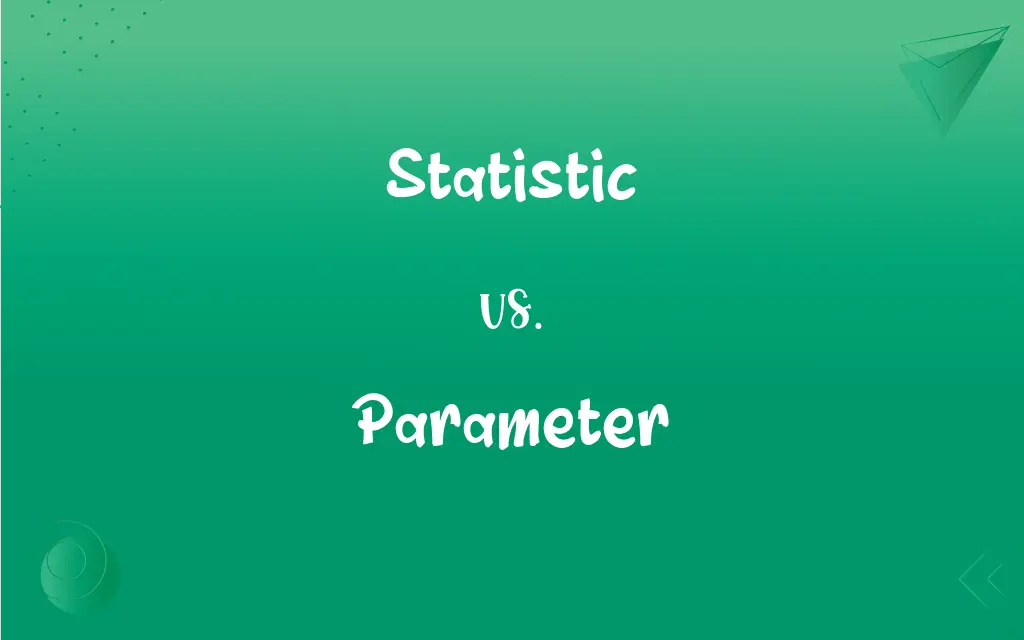Statistic vs. Parameter: What's the Difference?
Edited by Janet White || By Harlon Moss || Updated on October 20, 2023
A statistic is a measure derived from a sample, while a parameter is a measure derived from an entire population.

Key Differences
A statistic is a quantitative value that describes an aspect of a sample taken from a larger population. It offers a glimpse into the potential properties of the larger group without examining every member. On the other hand, a parameter pertains to the entire population and provides a definitive measure of its characteristics.
In the realm of data analysis, statisticians often work with samples because it is impractical or impossible to study every individual in a population. Consequently, they compute statistics. Parameters, however, are the true values that these statistics attempt to estimate.
When we hear about surveys or polls, the numbers presented are typically statistics. They are computed based on a subset of the whole group. Parameters, being derived from the entire population, are typically unknown and are what researchers aim to infer about using the statistics they gather.
To illustrate, consider the average height of students in a class as a statistic. It's a snapshot that might provide insight into the average height of students in the whole school, which would be the parameter. Both the statistic and the parameter give us valuable information, but their scopes differ.
Comparison Chart
Definition
A measure derived from a sample.
A measure derived from the entire population.
ADVERTISEMENT
Scope
Refers to a subset of the population (sample).
Refers to the entire population.
Typical Use
Used when it's impractical to study the whole population.
Represents the true value for the population.
Known or Unknown
Often known from collected data.
Typically unknown and estimated using statistics.
Example
Average score of a class test.
Average score of all students in the entire school year.
Statistic and Parameter Definitions
Statistic
A fact or piece of data obtained from a study of a large quantity of numerical data.
The sales statistic for the last quarter exceeded expectations.
ADVERTISEMENT
Parameter
A numerical characteristic of a population.
The parameter for average life expectancy has increased over the decades.
Statistic
A numerical value representing a property of a sample.
The statistic showed 60% of sampled residents preferred the new policy.
Parameter
A defining element or factor; a limit.
The construction project has strict parameters regarding budget.
Statistic
A datum that can be represented numerically.
Each student's grade is a statistic that contributes to the class average.
Parameter
A specific piece of data defined for a system or process.
The machine's settings include a parameter for temperature control.
Statistic
An outcome or result that provides information about a sample.
The company's growth statistic for the year was a positive 12%.
Parameter
A value that sets limits on a variable.
The software allows users to adjust various parameters for customization.
Statistic
An aggregated measure derived from data.
According to the latest statistic, unemployment has dropped by 2%.
Parameter
A quantity or constant whose value varies with the circumstances of its application.
In the equation, the parameter a determines the shape of the curve.
Statistic
A numerical piece of information.
Parameter
A constant in an equation that varies in other equations of the same general form, especially such a constant in the equation of a curve or surface that can be varied to represent a family of curves or surfaces.
Statistic
A calculated numerical value (such as the sample mean) that characterizes some aspect of a sample set of data, and that is often meant to estimate the true value of a corresponding parameter (such as the population mean) in an underlying population.
FAQs
Why might someone use a statistic instead of a parameter?
Studying an entire population might be impractical, so a sample statistic is used for estimation.
Are all statistics accurate representations of parameters?
Not necessarily; statistics provide estimates, and there may be sampling errors.
What's an example of a statistic in everyday life?
An example is the average score of students on a test in a classroom.
What is a statistic in simple terms?
A statistic is a numerical measure derived from a sample of data.
How do parameters relate to functions in math?
Parameters define certain characteristics of functions, often determining their shape or position.
In research, is it more common to work with statistics or parameters?
Statistics, since it's often challenging or impossible to gather data from an entire population.
How can I improve the accuracy of a statistic?
Increasing sample size and ensuring unbiased sampling can help improve accuracy.
Are there multiple parameters for a given population?
Yes, a population can have multiple parameters, such as mean, median, and mode.
How does a statistic differ from a parameter?
A statistic describes a sample, while a parameter describes an entire population.
Can a parameter be known with certainty?
In some cases, yes, but often parameters are estimated using statistics.
Are statistics always reliable?
Not always; they can be influenced by sample size, bias, and other factors.
Is a parameter fixed for a population?
For a given population at a given time, yes, but populations can change over time.
Do all studies that provide statistics help estimate parameters?
Most do, but the goal always depends on the research's objective.
What's an example of a parameter in everyday life?
The average score of all students in a school for an entire year would be a parameter.
Why is the distinction between statistic and parameter important?
Understanding the difference helps in accurate data interpretation and decision-making.
What's the relationship between a statistic and its reliability?
The reliability of a statistic depends on how it's derived and the quality of the sample.
Can parameters change over time?
Yes, as the characteristics of a population change, parameters can also change.
Are parameters always numerical?
In the context of data and populations, yes, but in other contexts, they can be non-numerical characteristics.
Can a statistic be used to infer a parameter?
Yes, statistics are often used to make inferences about population parameters.
What is a parameter in the context of mathematics?
It's a quantity that influences the output but remains constant within specific scenarios.
About Author
Written by
Harlon MossHarlon is a seasoned quality moderator and accomplished content writer for Difference Wiki. An alumnus of the prestigious University of California, he earned his degree in Computer Science. Leveraging his academic background, Harlon brings a meticulous and informed perspective to his work, ensuring content accuracy and excellence.
Edited by
Janet WhiteJanet White has been an esteemed writer and blogger for Difference Wiki. Holding a Master's degree in Science and Medical Journalism from the prestigious Boston University, she has consistently demonstrated her expertise and passion for her field. When she's not immersed in her work, Janet relishes her time exercising, delving into a good book, and cherishing moments with friends and family.
































































